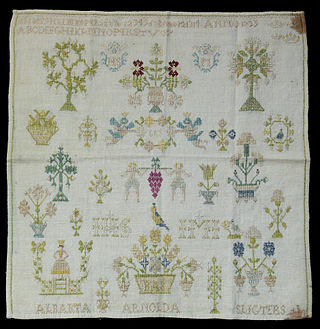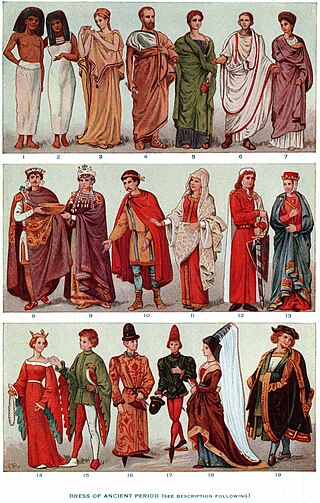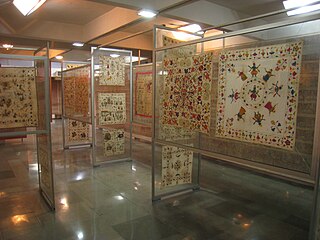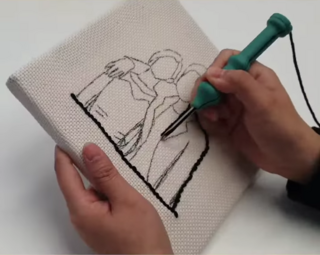Related Research Articles

Beadwork is the art or craft of attaching beads to one another by stringing them onto a thread or thin wire with a sewing or beading needle or sewing them to cloth. Beads are produced in a diverse range of materials, shapes, and sizes, and vary by the kind of art produced. Most often, beadwork is a form of personal adornment, but it also commonly makes up other artworks.

Cross-stitch is a form of sewing and a popular form of counted-thread embroidery in which X-shaped stitches in a tiled, raster-like pattern are used to form a picture. The stitcher counts the threads on a piece of evenweave fabric in each direction so that the stitches are of uniform size and appearance. This form of cross-stitch is also called counted cross-stitch in order to distinguish it from other forms of cross-stitch. Sometimes cross-stitch is done on designs printed on the fabric ; the stitcher simply stitches over the printed pattern. Cross-stitch is often executed on easily countable fabric called aida cloth, whose weave creates a plainly visible grid of squares with holes for the needle at each corner.

Embroidery is the art of decorating fabric or other materials using a needle to stitch thread or yarn. Embroidery may also incorporate other materials such as pearls, beads, quills, and sequins. In modern days, embroidery is usually seen on hats, clothing, blankets, and handbags. Embroidery is available in a wide variety of thread or yarn colour. It is often used to personalize gifts or clothing items.

Clothing is any item worn on the body. Typically, clothing is made of fabrics or textiles, but over time it has included garments made from animal skin and other thin sheets of materials and natural products found in the environment, put together. The wearing of clothing is mostly restricted to human beings and is a feature of all human societies. The amount and type of clothing worn depends on gender, body type, social factors, and geographic considerations. Garments cover the body, footwear covers the feet, gloves cover the hands, while hats and headgear cover the head, and underwear covers the private parts.

A needlework sampler is a piece of embroidery or cross-stitching produced as a 'specimen of achievement', demonstration or a test of skill in needlework. It often includes the alphabet, figures, motifs, decorative borders and sometimes the name of the person who embroidered it and the date. The word sampler is derived from the Latin exemplum, which means 'example'.

Drawn thread work is one of the earliest forms of open work embroidery, and has been worked throughout Europe. Originally it was often used for ecclesiastical items and to ornament shrouds. It is a form of counted-thread embroidery based on removing threads from the warp and/or the weft of a piece of even-weave fabric. The remaining threads are grouped or bundled together into a variety of patterns. The more elaborate styles of drawn thread work use a variety of other stitches and techniques, but the drawn thread parts are their most distinctive element. It is also grouped with whitework embroidery because it was traditionally done in white thread on white fabric and is often combined with other whitework techniques.

Lace is a delicate fabric made of yarn or thread in an open weblike pattern, made by machine or by hand. Generally, lace is split into two main categories, needlelace and bobbin lace, although there are other types of lace, such as knitted or crocheted lace. Other laces such as these are considered as a category of their specific craft. Knitted lace, therefore, is an example of knitting. This article considers both needle lace and bobbin lace.

A shawl is a simple item of clothing, loosely worn over the shoulders, upper body and arms, and sometimes also over the head. It is usually a rectangular piece of cloth, but can also be square or triangular in shape. Other shapes include oblong shawls. It is associated with the inhabitants of the northern Indian subcontinent—particularly Kashmir and Punjab—and Central Asia, but can be found in many other parts of the world.

Darning is a sewing technique for repairing holes or worn areas in fabric or knitting using needle and thread alone. It is often done by hand, but using a sewing machine is also possible. Hand darning employs the darning stitch, a simple running stitch in which the thread is "woven" in rows along the grain of the fabric, with the stitcher reversing direction at the end of each row, and then filling in the framework thus created, as if weaving. Darning is a traditional method for repairing fabric damage or holes that do not run along a seam, and where patching is impractical or would create discomfort for the wearer, such as on the heel of a sock.

Whitework embroidery is any embroidery technique in which the stitch and the foundation fabric are of same color. Styles of whitework embroidery include most drawn thread work, broderie anglaise, Hardanger embroidery, Hedebo embroidery, Mountmellick embroidery, reticella and Schwalm. Whitework embroidery is one of the techniques employed in heirloom sewing for blouses, christening gowns, baby bonnets, and other small articles. It has been used extensively on household and ecclesiastical linen, as decoration. It is often found on traditional regional and national costume, particularly on shirts, aprons and head coverings.

Embroidery in India includes dozens of embroidery styles that vary by region and clothing styles. Designs in Indian embroidery are formed on the basis of the texture and the design of the fabric and the stitch. The dot and the alternate dot, the circle, the square, the triangle, and permutations and combinations of these constitute the design.

The straight or running stitch is the basic stitch in hand-sewing and embroidery, on which all other forms of sewing are based. The stitch is worked by passing the needle in and out of the fabric at a regular distance. All other stitches are created by varying the straight stitch in length, spacing, and direction.

Nakshi kantha, a type of embroidered quilt, is a centuries-old Bengali art tradition of the Bengal region, notable in Bangladesh and Indian states of West Bengal, Tripura and part of Assam. The basic materials used are thread and old cloth. Nakshi kanthas are made throughout Bangladesh, primarily in the areas of Mymensingh, Jamalpur, Bogra, Rajshahi, Faridpur, Jessore, and Chittagong.

Kintsugi, also known as kintsukuroi, is the Japanese art of repairing broken pottery by mending the areas of breakage with urushi lacquer dusted or mixed with powdered gold, silver, or platinum. The method is similar to the maki-e technique. As a philosophy, it treats breakage and repair as part of the history of an object, rather than something to disguise.
Sewing is the craft of fastening or attaching objects using stitches made with needle and thread. Sewing is one of the oldest of the textile arts, arising in the Paleolithic Era. Although usually associated with clothing and household linens, sewing is used in a variety of crafts and industries, including shoemaking, upholstery, sailmaking, bookbinding and the manufacturing of some kinds of sporting goods. Sewing is the fundamental process underlying a variety of textile arts and crafts, including embroidery, tapestry, quilting, appliqué and patchwork.

The Kutch Embroidery is a handicraft and textile signature art tradition of the tribal community of Kutch District in Gujarat, India. This embroidery with its rich designs has made a notable contribution to the Indian embroidery traditions. The embroidery, practiced normally by women is generally done on fabrics of cotton, in the form of a net using cotton or silk threads. In certain patterns, it is also crafted over silk and satin. The types of stitches adopted are “square chain, double buttonhole, pattern darning, running stitch, satin and straight stitches”. The signature effect of the colorful embroidery sparkles when small mirrors called abhla are sewn over the geometrically shaped designs. Depending on the tribal sub groups of Rabari, Garasia Jat, and Mutava involved with this craft work many hand embroidered ethnic styles have evolved. These six styles: Suf, khaarek, Paako, Rabari, Garasia Jat, and Mutava.
Kasidakari is an embroidery art associated with Kashmir, Bihar, Punjab and Himachal.
Rafoogar is an artisan similar to an embroiderer, but the Rafoogar has the skill to repair the damaged or torn clothes. Rafoogar makes the holes, cuts, and manufacturing damages almost invisible. In Kashmir, the term is more associated with shawl making where the weavers were called Sada-baf and the workman for repairing work called Rafoogar.

A punch needle is a manual tool used for embroidery or rug making that creates a field of tightly-packed loops of thread or yarn on a woven fabric substrate. The tool generally consists of a hollow needle with an angled opening attached to a wooden or plastic handle. The needle's eye is drilled just above its tip, rather than at its base, as with most sewing needles. Yarn is threaded through the hollow needle via an opening at the top of its handle, and out through the eye.

Visible mending is a form of repair work, usually on textile items, that is deliberately left visible. The dual goals of this practice are to adorn the item, and to attract attention to the fact it has been mended in some way. The latter is often a statement of critique on the consumerist idea of replacing broken items with new ones without trying to bring them back to full functionality. In other words, the repair is supposed to be a new and distinct feature of the item.
References
- 1 2 "Arounna Khounnoraj talks making crafts in an immigrant family, and the importance of loving process". HelloGiggles . 4 July 2019. Archived from the original on 5 February 2023. Retrieved 6 January 2021.
- ↑ "About Us". bookhou. Archived from the original on 12 March 2023. Retrieved 6 January 2021.
- 1 2 Korducki, Kelli (26 July 2012). "Locally Made: The Art and Design of Bookhou". Torontoist . Photos by Corbin Smith. Archived from the original on 13 December 2012. Retrieved 6 January 2021.
- ↑ Vadino, Diane (August 2011). "Toronto". Lucky. 11 (8): 42. ISSN 1531-4294.
- ↑ Fleet, Sine (9 September 2019). "Meet the maker: Arounna Khounnoraj of bookhou". 91 Magazine. Archived from the original on 3 September 2023. Retrieved 6 January 2021.
- ↑ Day, Lauren Chorpening (October 2015). "Studio Tour: Arounna + John of Bookhou". Design*Sponge . Archived from the original on 24 August 2021. Retrieved 6 January 2021.
- ↑ Benning, Sarah K. (17 January 2018). "Craft With Conscience: Arounna khounnoraj of Bookhou". Sarah K. Benning Contemporary Embroidery. Archived from the original on 28 February 2023. Retrieved 6 January 2021.
- ↑ Shan, Shuang Esther (8 January 2020). "Partners: They're Running the Modern Day Mom and Pop Shop". Shopify . Archived from the original on 28 March 2023. Retrieved 6 January 2021.
- 1 2 Norton, Debra (12 July 2019). "Toronto artist gives punch needle crafting a modern twist". Toronto Star . Archived from the original on 3 September 2023. Retrieved 6 January 2021.
- ↑ Dorset, Lish (2018). "Creative Genius: Arounna Khounnoraj of Bookhou". HGTV . Archived from the original on 7 October 2022. Retrieved 6 January 2021.
- 1 2 Koenig, Ravenna (3 June 2023). "If you want to fix your own clothes, try this easy style of mending". NPR . Archived from the original on 6 August 2023. Retrieved 3 September 2023.
- ↑ Khounnoraj, Arounna (2019). Punch Needle. Photography by Catherine Frawley. London: Quadrille. ISBN 9781787132788. OCLC 1090439560.
- 1 2 Gulli, Cathy (12 May 2022). "Designer Arounna Khounnoraj of Toronto's Bookhou uses social media to breathe new life into traditional crafts". The Globe and Mail . Archived from the original on 10 March 2023. Retrieved 3 September 2023.
- ↑ Khounnoraj, Arounna (2020). Visible Mending: Repair, Renew, Reuse the Clothes You Love. London: Quadrille. ISBN 9781787136090. OCLC 1202472359.
- ↑ Voon, Claire (8 March 2021). "Making It: Let It Show with Visible Mending". ARTnews . Archived from the original on 1 February 2023. Retrieved 3 September 2023.
- ↑ Khounnoraj, Arounna (2022). Embroidery: A Modern Guide to Botanical Embroidery. Photography by Lauren Kolyn. London: Quadrille. ISBN 9781787138315. OCLC 1258656145.
- ↑ Khounnoraj, Arounna (2023). Winter Celebrations: A Modern Guide to a Handmade Christmas. London: Quadrille. ISBN 9781837830664. OCLC 1360284229.
- 1 2 Martin, Kristen (11 August 2023). "Homemade Crafts for the Holidays: PW Talks with Arounna Khounnoraj". Publishers Weekly . Archived from the original on 13 August 2023. Retrieved 3 September 2023.
- ↑ Khounnoraj, Arounna (2023). Contemporary Patchwork: Techniques in Colour, Surface Design & Sewing. Lafayette: Stash Books. ISBN 9781644033753. OCLC 1389487142.